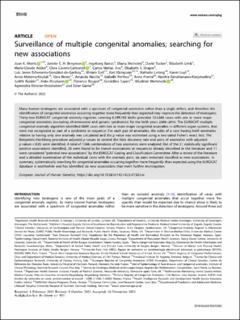Surveillance of multiple congenital anomalies; searching for new associations
Morris, Joan K.; Bergman, Jorieke E. H.; Barisic, Ingeborg; Wellesley, Diana; Tucker, David; Limb, Elizabeth; Addor, Marie-Claude; Cavero-Carbonell, Clara; Matias Dias, Carlos; Draper, Elisabeth S.; Echevarría-González-de-Garibay, Luis Javier; Gatt, Miriam; Klungsøyr, Kari; Lelong, Nathalie; Luyt, Karen; Materna-Kiryluk, Anna; Nelen, Vera; Neville, Amanda; Perthus, Isabelle; Pierini, Anna; Randrianaivo-Ranjatoelina, Hanitra; Rankin, Judith; Rissmann, Anke; Rouget, Florence; Sayers, Geraldine; Wertelecki, Wladimir; Kinsner-Ovaskainen, Agnieszka; Garne, Ester
Journal article, Peer reviewed
Published version

View/
Date
2023Metadata
Show full item recordCollections
Abstract
Many human teratogens are associated with a spectrum of congenital anomalies rather than a single defect, and therefore the identification of congenital anomalies occurring together more frequently than expected may improve the detection of teratogens. Thirty-two EUROCAT congenital anomaly registries covering 6,599,765 births provided 123,566 cases with one or more major congenital anomalies (excluding chromosomal and genetic syndromes) for the birth years 2008–2016. The EUROCAT multiple congenital anomaly algorithm identified 8804 cases with two or more major congenital anomalies in different organ systems, that were not recognized as part of a syndrome or sequence. For each pair of anomalies, the odds of a case having both anomalies relative to having only one anomaly was calculated and the p value was estimated using a two-sided Fisher’s exact test. The Benjamini–Hochberg procedure adjusted p values to control the false discovery rate and pairs of anomalies with adjusted p values < 0.05 were identified. A total of 1386 combinations of two anomalies were analyzed. Out of the 31 statistically significant positive associations identified, 20 were found to be known associations or sequences already described in the literature and 11 were considered “potential new associations” by the EUROCAT Coding and Classification Committee. After a review of the literature and a detailed examination of the individual cases with the anomaly pairs, six pairs remained classified as new associations. In summary, systematically searching for congenital anomalies occurring together more frequently than expected using the EUROCAT database is worthwhile and has identified six new associations that merit further investigation.
